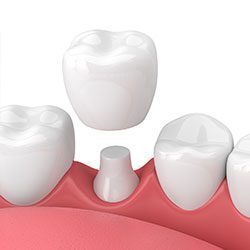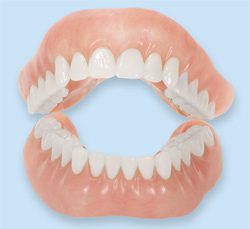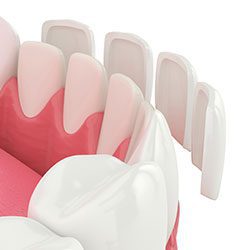Vibrant Cosmetic Dentistry in Las Vegas, NV

Your smile is one of your most important features. Dentistry is continually evolving, and with a variety of advanced treatment options, achieving a beautiful, healthy, aesthetic smile is made easy for patients of all ages.
ARE YOU READY FOR A SMILE MAKEOVER?
If you’re considering cosmetic dental treatment, ask yourself a few simple questions:
- Do you hesitate when you smile?
- Would you like to increase your self-confidence?
- Do you want to look your best in social or professional situations?
- Are you ready to reverse any dental imperfections you may have?
If you’ve answered yes to any of these questions, cosmetic dentistry may be the answer you’ve been looking for!
COSMETIC DENTISTRY IS AN ART AND A SCIENCE
Let us help you achieve your smile goals! Cosmetic dentistry is different from general dental care; it is both an art and science. By providing cosmetic dental care, your dentist is able to offer smile enhancement, restoration, and maintenance treatments for optimal dental health. Using cutting-edge techniques and advanced materials, our office proudly offers you a beautiful, natural smile and all the benefits that come with it.
Feel more confident about your appearance with a new smile that is as beautiful as it is healthy. You no longer have to suffer from missing, chipped, discolored, or crooked teeth. Contact our practice today and schedule your smile makeover!
A dental bridge is a fixed (non-removable) appliance and is an excellent way to replace missing teeth.
There are several types of bridges. You and your dentist will discuss the best options for your particular case.
The “traditional bridge” is the most popular type and is usually made of porcelain fused to metal. Porcelain fixed bridges are most popular because they resemble your natural teeth. This type of bridge consists to two crowns that go over two anchoring teeth (abutment teeth) and are attached to pontics (artificial teeth), filling the gap created by one or more missing teeth.
Dental bridges are highly durable and will last many years, however they may need replacement or need to be re-cemented due to normal wear.
Reasons for a fixed bridge
- Fill space of missing teeth
- Maintain facial shape
- Prevent remaining teeth from drifting out of position
- Restore chewing and speaking ability
- Restore your smile
- Upgrade from a removable partial denture to a permanent dental appliance
What does getting a fixed bridge involved?
Getting a bridge usually requires two or more visits. While the teeth are numb, the two anchoring teeth are prepared by removing a portion of enamel to allow for a crown. Next, a highly accurate impression (mold) is made which will be sent to a dental laboratory where the bridge will be fabricated. In addition, a temporary bridge will be made and worn for several weeks until your next appointment.
At the second visit, your permanent bridge will be carefully checked, adjusted, and cemented to achieve a proper fit. Occasionally your dentist may only temporarily cement the bridge, allowing your teeth and tissue time to get used to the new bridge. The new bridge will be permanently cemented at a later time.
As technologies have advanced in dental care in recent years, one of the very best products to emerge is none other than invisible braces, also known as clear aligners. At Dental Nation, we offer the very best invisible braces in Las Vegas because we feature ClearCorrect, a terrific alternative to Invisalign. This discreet, clear aligner system is made for both teens and adults and allows for your teeth to be corrected, without any of the difficult aspects of wearing wires and brackets.


ClearCorrect Patient Review:
What Are ClearCorrect Clear Aligners?
ClearCorrect is a great method to discreetly straighten teeth. These aligners are specifically molded to your teeth and are nearly invisible to the naked eye. These are preferred over traditional forms of orthodontics in that they don’t require any dietary restrictions or obstructions to brushing and flossing. This is a great method to use if you are trying to straighten your teeth. In fact, you can experience results in less than 6 months!
Benefits of ClearCorrect invisible braces
- Clear aligners. ClearCorrect’s aligners are custom designed to look like you are wearing nothing but your natural smile!
- Easy maintenance. Removable for simple cleaning and oral care.
- No dietary restrictions. Enjoy all your favorite foods.
- Rapid treatment. Many patients complete their ClearCorrect treatment in 1 year or less.
- Increased comfort. ClearCorrect invisible braces can be more comfortable than wearing traditional braces.
How Do ClearCorrect Braces Work?
When you decide to move forward with ClearCorrect, your dentist will take a mold of your teeth. This mold will show the shape of your teeth, making it possible for the ClearCorrect aligners to be made.
Once your aligners are made, you will come back in for your follow-up appointment where your aligners will be fitted to your teeth. You will then be provided with instructions on how long you should wear your aligners each day, as well as how to properly care for them.
Are Invisible Braces Right for Me?
Whether you have already been treated by an orthodontist years ago or this is your first time straightening your teeth, ClearCorrect is likely an excellent choice for you. The system is designed to treat a wide range of conditions including:
- Gap teeth
- Crowded teeth
- Crossbites
- Underbites
- Overbites
- Open bites
- Turned teeth
- and more!
How Much Does ClearCorrect Cost?
Your total ClearCorrect cost will depend on the following:
- The length of your treatment plan
- If any preliminary treatments are required
- If any post-orthodontic treatment is required
Call Today to schedule Your ClearCorrect Invisible Braces Consultation with Dental Nation!
Crowns are a restorative procedure used to improve your tooth’s shape or to strengthen a tooth. Crowns are most often used for teeth that are broken, worn, or have portions destroyed by tooth decay.
A crown is a “cap” cemented onto an existing tooth that usually covers the portion of your tooth above the gum line. In effect, the crown becomes your tooth’s new outer surface. Crowns can be made of porcelain, metal, or both. Porcelain crowns are most often preferred because they mimic the translucency of natural teeth and are very strong.
Crowns or onlays (partial crowns) are needed when there is insufficient tooth strength remaining to hold a filling. Unlike fillings, which apply the restorative material directly into your mouth, a crown is fabricated away from your mouth. Your crown is created in a lab from your unique tooth impression, which allows a dental laboratory technician to examine all aspects of your bite and jaw movements. Your crown is then sculpted just for you so that your bite and jaw movements function normally once the crown is placed.


Dentures are natural-looking replacement teeth that are removable. There are two types of dentures: full and partial. Full dentures are given to patients when all of the natural teeth have been removed. Partial dentures are attached to a metal frame that is connected to your natural teeth and are used to fill in where permanent teeth have been removed. Just like natural teeth, dentures need to be properly cared for. Use a gentle cleanser to brush your dentures, always keep them moist when they’re not in use, and be sure to keep your tongue and gums clean as well.
Traditional dental restoratives, or fillings, are most often made of silver amalgam. The strength and durability of this traditional dental material makes it useful for situations where restored teeth must withstand extreme forces that result from chewing, often in the back of the mouth.
Newer dental fillings include ceramic and plastic compounds that mimic the appearance of natural teeth. These compounds, often called composite resins, are usually used on the front teeth where a natural appearance is important, but they can also be used on the back teeth depending on the location and extent of the tooth decay.
There are two different kinds of fillings: direct and indirect. Direct fillings are fillings placed into a prepared cavity in a single visit. They include silver amalgam, glass ionomers, resin ionomers, and composite (resin) fillings. Indirect fillings generally require two or more visits. They include inlays, onlays, and veneers. They are used when a tooth has too much damage to support a filling but not enough to necessitate a crown.

There are many products and techniques available for patients who want to achieve a brighter smile, and with so many options available, it can be difficult to choose the method that is right for you. The best way to begin any teeth-whitening regimen is to schedule an appointment and talk to your doctor about the differences between in-office professional whitening and at-home whitening.

In-Office Teeth Whitening
The first professional option is commonly referred to as in-office whitening. This procedure is performed in a dental office. During an appointment, your dental professional will apply a whitening gel to the surface of your teeth. The entire office visit generally takes about 90 minutes and you will be able to see results immediately.
At-home Teeth Whitening
- Custom Take Home Whitening Trays
Tray bleaching is a type of professional whitening that uses custom-made trays and whitening gel only available through your dentist. The whitening gel is placed in custom-fitted trays that fit perfectly over your teeth. As the peroxide in the gel breaks down, hydroxyradicals help whiten stained teeth. Unlike strips, this process whitens all your natural teeth and may contain ingredients intended to provide maximum comfort. At-home professional tray whitening generally takes ten to 14 days, although you may notice results in as little as three to five days.
- Paint-On Teeth Whiteners
There are many over-the-counter teeth whitening options, and one type of readily accessible whitening products is commonly referred to as a “paint-on” teeth whitener. Paint-on whiteners can be purchased over-the-counter and generally are less expensive and less effective than whitening strips or professional options. Paint-on teeth whiteners consist of a gel that is applied to the tooth using a small brush. Paint-on whitening gel hardens into a film that coats the teeth, and dissolves in the mouth. As with any teeth-whitening regimen, it is wise to consult with a dental professional before use.
- Teeth-Whitening Strips
Teeth-whitening strips are thin, flexible plastic (polyethylene) strips with a thin film of hydrogen peroxide on one side. Whitening strip kits come with two types of strips: strips for the upper teeth and strips for the lower teeth. The whitening agent is applied by placing the strips across your teeth and gently pressing the strips to ensure contact with all your teeth. Teeth-whitening strips are typically worn for 30 minutes a day, twice a day. The duration of treatment will vary.
- Whitening Toothpaste and Mouthwash
The least expensive options are whitening toothpastes and mouthwashes. Designed to have “whitening” capabilities, toothpastes and mouthwashes work to remove surface stains using mild abrasives. However, unlike the materials used in professional whitening procedures, these products do not lighten the actual color shade of the tooth. Whitening toothpastes affect surface stains and will mildly lighten your teeth.
You no longer need to hide your smile because of gaps, chips, stains, or misshapen teeth. With veneers, you can easily correct your teeth’s imperfections to help you have a more confident, beautiful smile. Veneers are natural in appearance, and they are a perfect option for patients wanting to make minor adjustments to the look and feel of their smile.
Veneers are thin, custom-made shells made from tooth-colored materials (such as porcelain), and they are designed to cover the front side of your teeth. To prepare for veneers, your doctor will create a unique model of your teeth. This model is sent to the dental technician to create your veneers. Before placing your new veneer, your doctor may need to conservatively prepare your tooth to achieve the desired aesthetic result.
When your veneers are placed, you’ll be pleased to see that they look like your natural teeth. While veneers are stain-resistant, your doctor may recommend that you avoid coffee, tea, red wine, and tobacco to maintain the beauty of your new smile.

